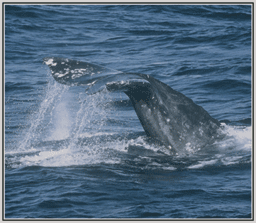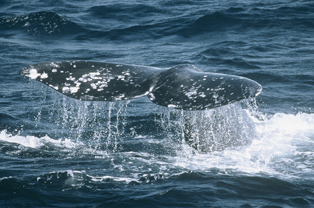|
California Gray Whales (Eschrichtius robustus)
 The
Gray Whale gets it's name not so much for the color of its skin, which
is essentially black, but because of the grayish appearance caused by
the accumulation of marine parasites... barnacles and whale lice
that attach themselves to their skin. Measuring 30 to 45 feet as
adults, and weighing about a ton a foot, the Gray Whale is a medium
sized whale - smaller than their larger Blue and Humpback Whale
cousins, but still much larger than any land animal on earth today. The
Gray Whale gets it's name not so much for the color of its skin, which
is essentially black, but because of the grayish appearance caused by
the accumulation of marine parasites... barnacles and whale lice
that attach themselves to their skin. Measuring 30 to 45 feet as
adults, and weighing about a ton a foot, the Gray Whale is a medium
sized whale - smaller than their larger Blue and Humpback Whale
cousins, but still much larger than any land animal on earth today.
Gray
Whales do not have a dorsal fin as the other great whales do. Instead
they display a series of "knuckles" along the after portion of the
back. As with all baleen whales, they have double-ported blowholes,
giving their spout a distinctive heart shaped appearance when viewed
from behind.
They are one of the most
predictable of all whale herds. Traveling some 8,000-12,000 miles every
year from their feeding grounds in the cold nutrient rich arctic waters
where they feed on bottom crustaceans, called amphipods, which they
furrow out of the silt at the mouths of the northern rivers. In fall
and winter they migrate all the way south to the warm water, shallow
lagoons of Baja California where they mate and bear their young.
This
predictable pattern brings them close along the coastal areas of the
entire West Coast which made them particularly vulnerable to whalers
during the whaling era, and now making them accessible to thousands of
whale watchers every year from Vancouver to Mexico.
The
story of the California Gray Whales is one of the great environmental
success stories of this century. Twice hunted to near extinction in the
last hundred years, the Gray Whale population has rebounded in the last
50 years to an estimated population of nearly 30,000 animals. In fact,
most scientists feel that there are as many California Gray Whales
today as there ever were.
 Even
the Korean Gray Whale, a taxonomically identical animal that also feeds
in the cold northern waters but migrates down the western shores of the
Pacific Basin along the coasts of Manchuria, Korea and Japan, has shown
an increase in numbers now that they are protected. It is hoped that
this stock will continue to increase and that we will once again have
two strong herds of Gray Whales in the Pacific Basin. Even
the Korean Gray Whale, a taxonomically identical animal that also feeds
in the cold northern waters but migrates down the western shores of the
Pacific Basin along the coasts of Manchuria, Korea and Japan, has shown
an increase in numbers now that they are protected. It is hoped that
this stock will continue to increase and that we will once again have
two strong herds of Gray Whales in the Pacific Basin.
Gray
Whales travel in groups of 3 to 12 or more animals called pods. Moving
at a slow but steady speed of about 3-5 knots and will average about
100 miles per day. Amazingly, since they feed primarily in the Arctic
and feed very little, if at all, on the migration, these great animals
make most of this long trip on stored body energy. This is particularly
remarkable in the case of the calf bearing females who, after going
through the rigors of calving, must make the long migration back to
their feeding grounds while producing gallons of fat-rich milk a day to
feed their calfナ all from fat stored in their layer of "blubber".
During
El Nino years, however, there is evidence that these animals may be
"nutrition stressed" - as they have been seen in the Santa Barbara
Channel feeding in patches of krill, even in the company of humpback
and blue whales. Since they are not well equipped to be top water
feeders - they lack a significant throat pouch, for example - they must
expend a lot of energy to harvest the smaller, more mobile krill.
In
the Santa Barbara Channel the southern migration takes the animals near
the Channel Islands, especially through the gap between Santa Cruz and
Santa Rosa Islands, beginning in late December and continuing through
February. The northern migration, however, brings the herd much closer
to Santa Barbara. During the months of February, March, April and
mid-May the entire herd will pass within just a few miles of Santa
Barbara Harbor. In fact, during the months of April-May which is the
cow/calf migration, most of the animals are seen within a few hundred
yards of shore. Often they are just at the
surf line, easily visible from bluffs along the shore. The cows hug the
shoreline in an effort to hide the calves from marauding packs of
Orcas, or Killer Whales, which will attack and kill the young Gray
Whales. Over the years, we have witnessed several Orca attacks on Gray
Whale calves in this area from the decks of the CONDOR.
Gray Whale watching trips on the new CONDOR EXPRESS run from mid-February to mid-May. We run 3 trips daily at 9am, noon and 3pm. Reservations can be made by calling 805-882-0088 or (toll free) 1-888-77WHALE. Group rates are available.
{justsoRegion} |



